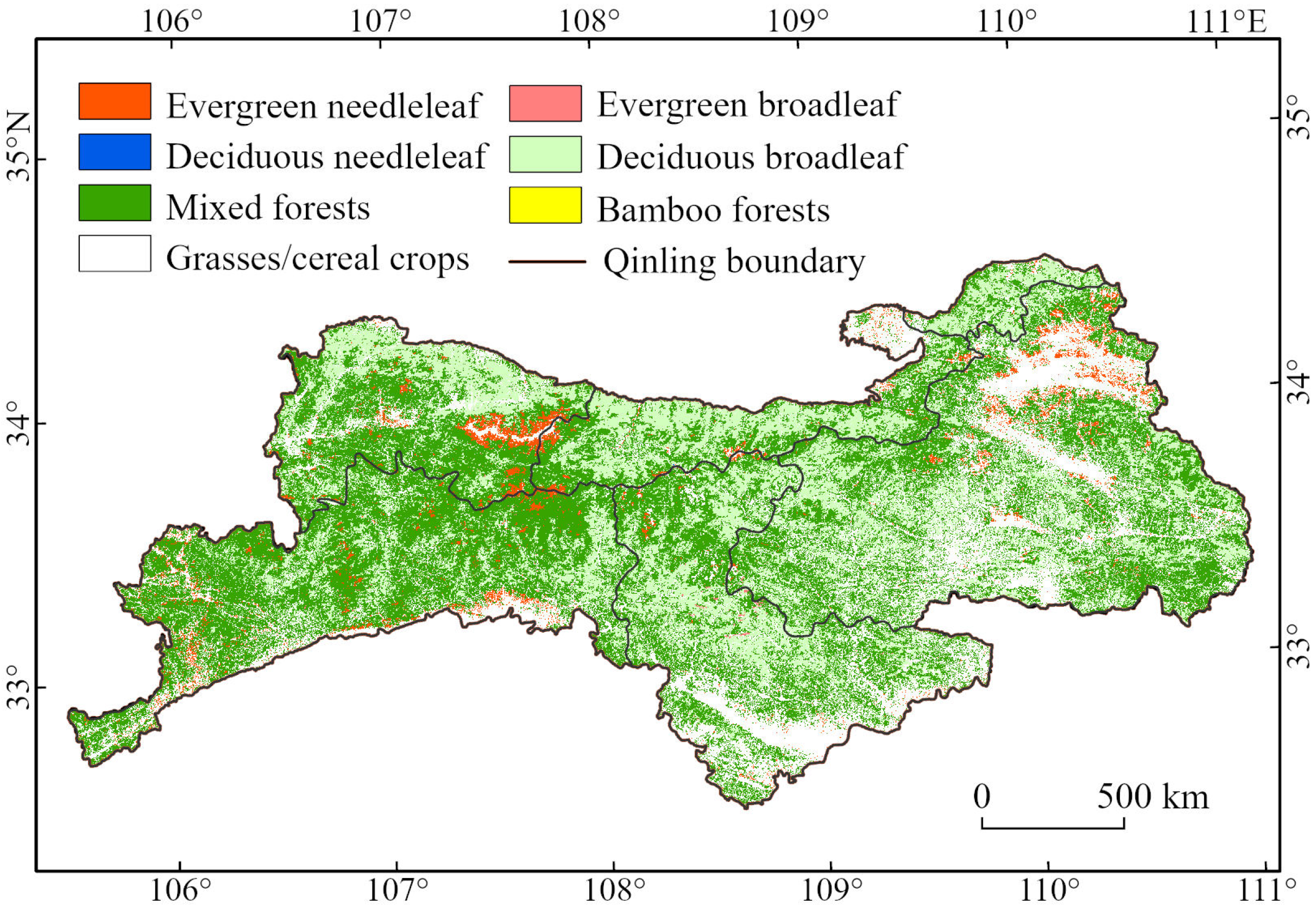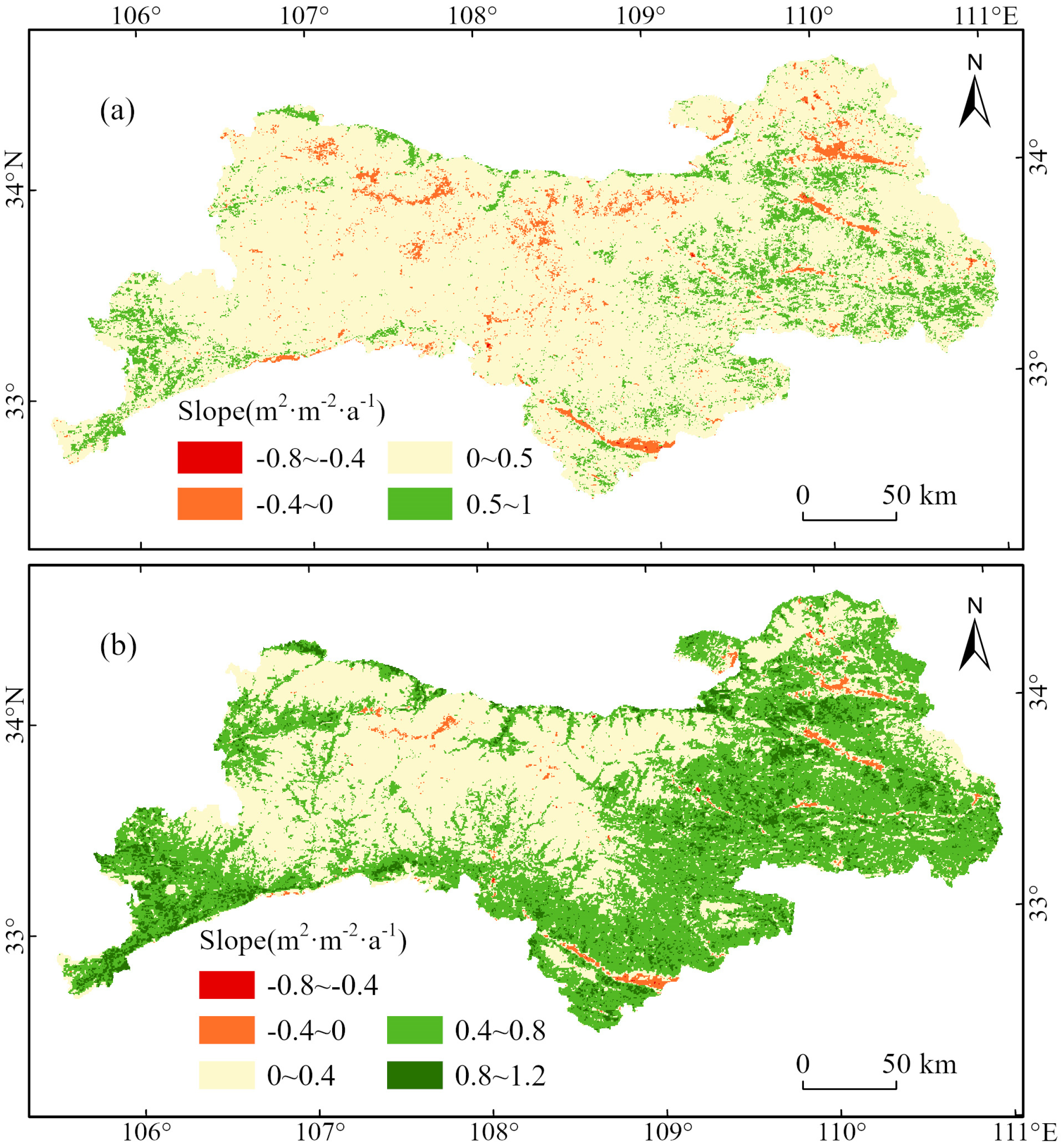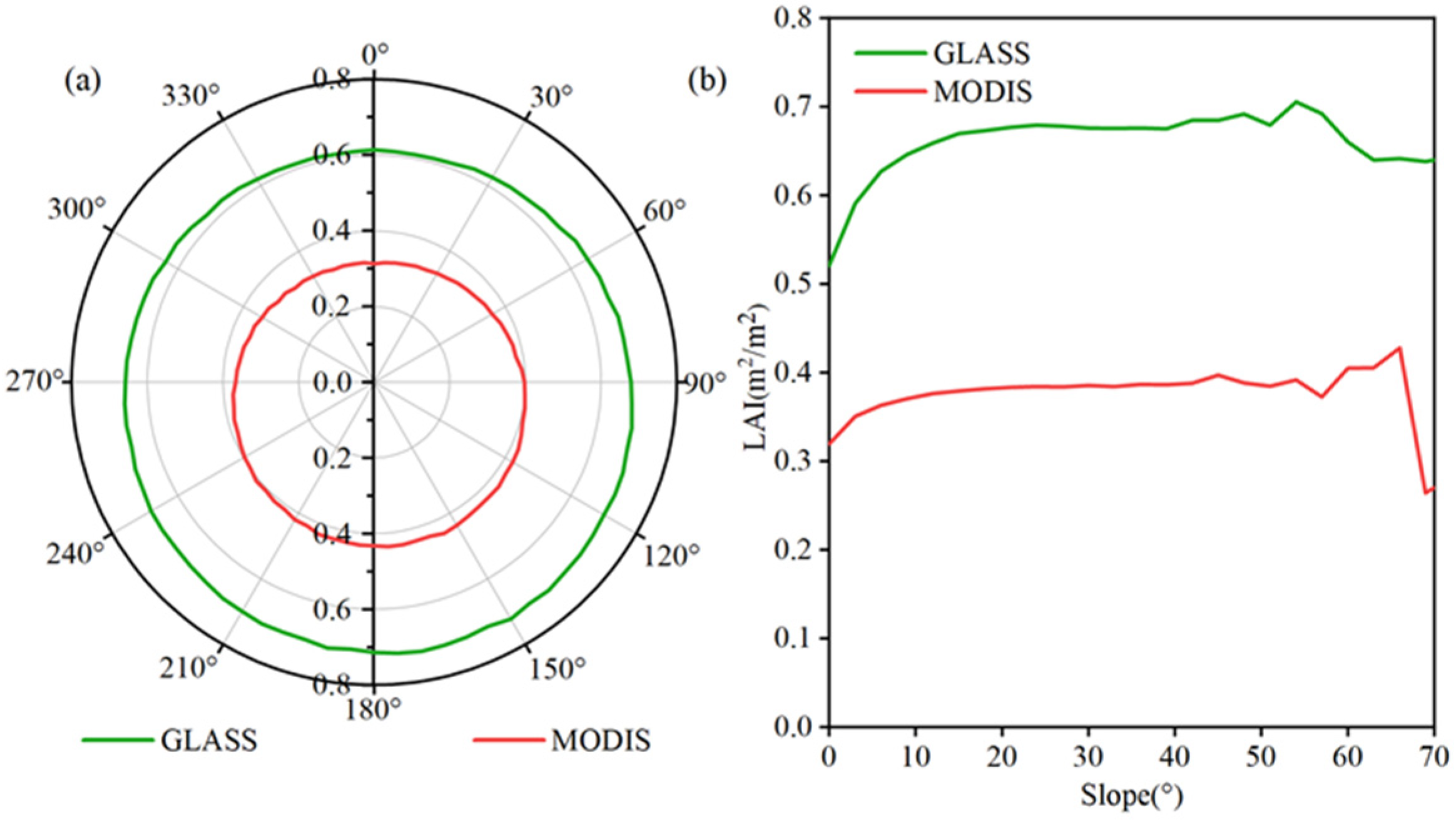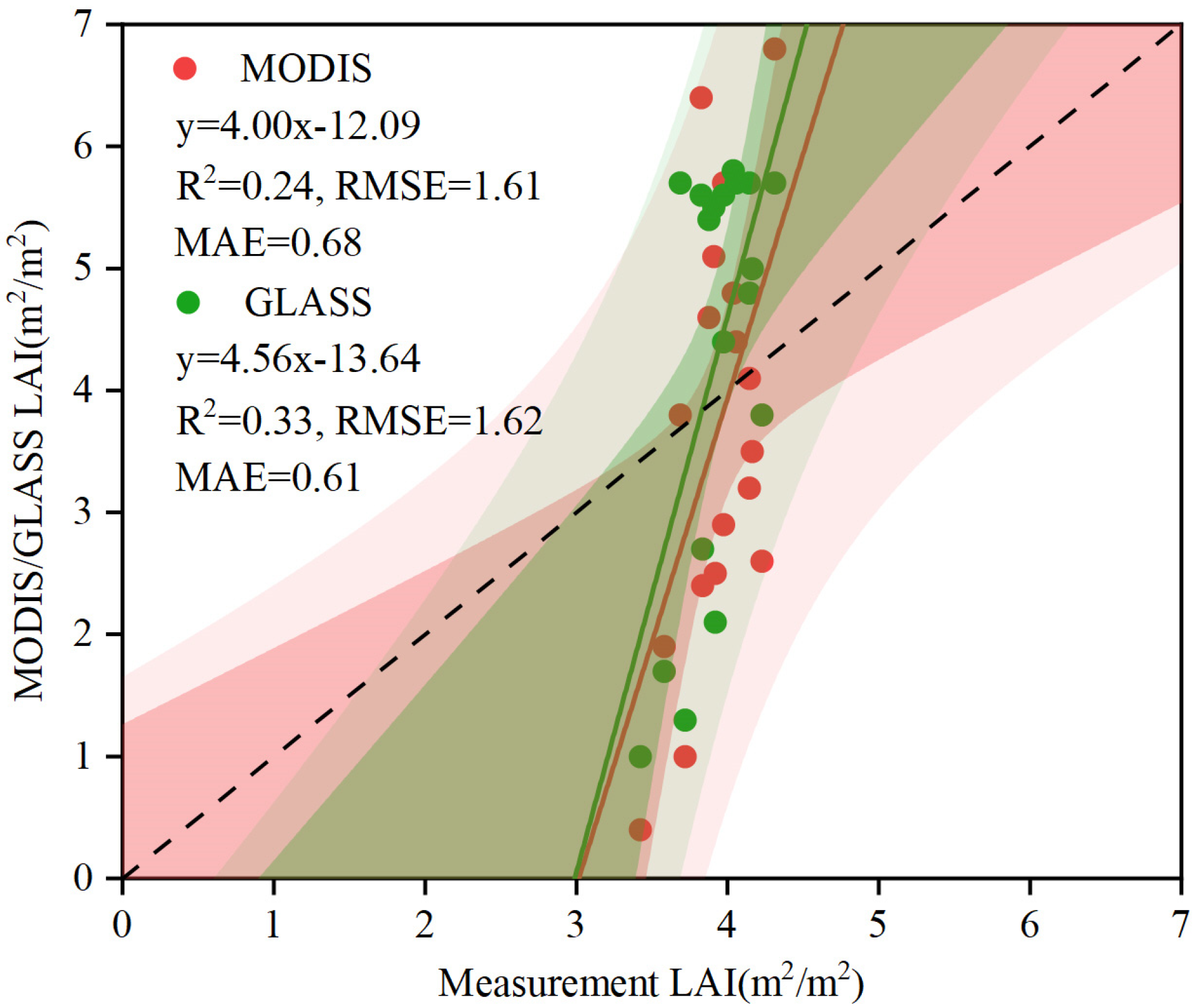Influence of Terrain on MODIS and GLASS Leaf Area Index (LAI) Products in Qinling Mountains Forests
Abstract
1. Introduction
2. Materials and Data
2.1. Study Area
2.2. Data
2.2.1. MODIS LAI Product
2.2.2. GLASS LAI Product
2.2.3. LAI Measurement Data
2.2.4. Vegetation Type Data
2.2.5. Digital Elevation Model (DEM) Data
3. Methods
3.1. Spatial Consistency Validation
3.2. Temporal Consistency Validation
3.3. Consistency Validation Under Topographic Factors
3.4. Quality Evaluation of LAI Products
4. Results
4.1. Spatio-Temporal Consistency of LAI Products
4.1.1. Spatial Consistency of MODIS and GLASS LAI Products
4.1.2. Temporal Consistency of MODIS and GLASS LAI Products
4.2. Consistency of LAI Products Under the Influence of Topographic Factors
4.2.1. Consistency in the Distribution of LAI Products with Aspect and Slope
4.2.2. Consistency in the Distribution of LAI Products with Elevation
4.3. Direct Validation
5. Discussion
5.1. Analysis of Spatio-Temporal Consistency of LAI Products
5.2. Uncertainty Analysis of LAI Products in Mountainous Areas
5.3. Accuracy Validation of LAI Products
6. Conclusions
- (1)
- For spatial consistency, GLASS LAI values are generally higher than MODIS LAI values. The proportions of pixels with higher GLASS LAI values compared to MODIS LAI values in January and July are 99.89% and 97.14%, respectively. For different vegetation types, the difference in LAI frequency distribution between the two LAI products is small for evergreen needleleaf forests. The MODIS LAI values exhibit a higher frequency within the range of 2.5 to 3.5, while the GLASS LAI product displays peak frequencies within the LAI range of 2.5 to 4.5. For temporal consistency, the temporal series curve of the GLASS LAI product is smoother, while the temporal series of the MODIS LAI product is more erratic, particularly with sudden peaks, troughs, and low values during the growing season. The LAI changes in the Qinling Mountains mainly show an increasing trend, with 96.09% and 98.71% of the regions demonstrating a positive change for the two LAI products, respectively, while 0.35% and 0.37% of the regions exhibit a significant decrease.
- (2)
- The MODIS and GLASS LAI products exhibit disparities between sunny and shady slopes, with the mean LAI peaking on sunny slopes and minimizing on shady slopes for both. Within various slope ranges, the mean values of both LAI products primarily maintain stability or increase. Notably, at slopes of 0–10°, the mean values of the GLASS LAI product demonstrate a marked increasing trend compared to the MODIS LAI product. Conversely, at slopes exceeding 40°, the mean values of the MODIS LAI product exhibit pronounced fluctuations. As altitude increases, the mean values of both the MODIS and GLASS LAI product generally follow an initial increase and subsequent decrease trend. Specifically, at an elevation of 1450–2450 m, the mean values of the GLASS LAI product significantly surpass the MODIS LAI product, predominantly distributed in the southern Qinling Mountains.
- (3)
- Compared with ground-measured LAI data, the GLASS LAI product (R2 = 0.33, RMSE = 1.62) exhibits higher accuracy and correlation, while the MODIS LAI product (R2 = 0.24, RMSE = 1.61) performs relatively poorly. In the Qinling Mountains, both LAI products exhibit certain deviations, and the overall distribution of the sample results exhibits considerable dispersion relative to the 1:1 line distribution.
Author Contributions
Funding
Data Availability Statement
Conflicts of Interest
References
- Chen, J.; Black, T. Defining Leaf Area Index for non-flat leaves. Plant Cell Environ. 1992, 15, 421–429. [Google Scholar] [CrossRef]
- Jin, H.; Li, A.; Wang, J.; Bo, Y. Improvement of spatially and temporally continuous crop leaf area index by integration of CERES-Maize model and MODIS data. Eur. J. Agron. 2016, 78, 1–12. [Google Scholar] [CrossRef]
- Wulder, M.A.; Hall, R.J.; Coops, N.C.; Franklin, S.E. High spatial resolution remotely sensed data for ecosystem characterization. Bioscience 2004, 54, 511–521. [Google Scholar] [CrossRef]
- Luo, S.; Wang, C.; Zhang, G.; Xi, X.; Li, G. Forest leaf area index (LAI) inversion using airborne LiDAR data. Chin. J. Geophys. 2013, 56, 1467–1475. [Google Scholar] [CrossRef]
- Mthembu, N.; Lottering, R.; Kotze, H. Forest, Crop and Grassland Leaf Area Index Estimation Using Remote Sensing: A Review of Current Research Methods, Sensors, Estimation Models and Accomplishments. Appl. Sci. 2023, 13, 4005. [Google Scholar] [CrossRef]
- Fang, H.; Baret, F.; Plummer, S.; Schaepman-Strub, G. An Overview of Global Leaf Area Index (LAI): Methods, Products, Validation, and Applications. Rev. Geophys. 2019, 57, 739–799. [Google Scholar] [CrossRef]
- Luo, X.; Jin, L.; Tian, X.; Chen, S.; Wang, H. A High Spatiotemporal Enhancement Method of Forest Vegetation Leaf Area Index Based on Landsat8 OLI and GF-1 WFV Data. Remote Sens. 2023, 15, 2812. [Google Scholar] [CrossRef]
- Kobayashi, T.; Kobayashi, H.; Yang, W.; Murakami, H.; Honda, Y.; Nasahara, K.N. The development of a global LAI and FAPAR product using GCOM-C / SGLI data. Isprs J. Photogramm. 2023, 202, 479–498. [Google Scholar] [CrossRef]
- Li, J.; Xiao, Z. Evaluation of the version 5.0 global land surface satellite (GLASS) leaf area index product derived from MODIS data. Int. J. Remote Sens. 2020, 41, 9140–9160. [Google Scholar] [CrossRef]
- Yu, H.; Yin, G.; Liu, G.; Ye, Y.; Qu, Y.; Xu, B.; Verger, A. Validation of Sentinel-2, MODIS, CGLS, SAF, GLASS and C3S Leaf Area Index Products in Maize Crops. Remote Sens. 2021, 13, 4529. [Google Scholar] [CrossRef]
- Liu, T.; Jin, H.; Li, A.; Fang, H.; Wei, D.; Xie, X.; Nan, X. Estimation of Vegetation Leaf-Area-Index Dynamics from Multiple Satellite Products through Deep-Learning Method. Remote Sens. 2022, 14, 4733. [Google Scholar] [CrossRef]
- Zhang, W.; Jin, H.; Shao, H.; Li, A.; Li, S.; Fan, W. Temporal and Spatial Variations in the Leaf Area Index and Its Response to Topography in the Three-River Source Region, China from 2000 to 2017. Isprs Int. J. Geo-Inf. 2021, 10, 33. [Google Scholar] [CrossRef]
- Pasolli, L.; Asam, S.; Castelli, M.; Bruzzone, L.; Wohlfahrt, G.; Zebisch, M.; Notarnicola, C. Retrieval of Leaf Area Index in mountain grasslands in the Alps from MODIS satellite imagery. Remote Sens. Environ. 2015, 165, 159–174. [Google Scholar] [CrossRef]
- Yu, W.; Li, J.; Liu, Q.; Yin, G.; Zeng, Y.; Lin, S.; Zhao, J. A Simulation-Based Analysis of Topographic Effects on LAI Inversion Over Sloped Terrain. IEEE J. Sel. Top. Appl. Earth Obs. Remote Sens. 2020, 13, 794–806. [Google Scholar] [CrossRef]
- Qi, G.; Song, J.; Li, Q.; Bai, H.; Sun, H.; Zhang, S.; Cheng, D. Response of vegetation to multi-timescales drought in the Qinling Mountains of China. Ecol. Indic. 2022, 135, 108539. [Google Scholar] [CrossRef]
- Shi, X.; Yang, Z.; Dong, Y.; Zhou, B. Tectonic uplift of the northern Qinling Mountains (Central China) during the late Cenozoic: Evidence from DEM-based geomorphological analysis. J. Asian Earth Sci. 2019, 184, 104005. [Google Scholar] [CrossRef]
- Shao, Y.; Mu, X.; He, Y.; Sun, W.; Zhao, G.; Gao, P. Spatiotemporal variations of extreme precipitation events at multi-time scales in the Qinling-Daba mountains region, China. Quatern Int. 2019, 525, 89–102. [Google Scholar] [CrossRef]
- Yu, F.; Li, C.; Yuan, Z.; Luo, Y.; Yin, Q.; Wang, Q.; Hao, Z. How do mountain ecosystem services respond to changes in vegetation and climate? An evidence from the Qinling Mountains, China. Ecol. Indic. 2023, 154, 110922. [Google Scholar] [CrossRef]
- Lan, X.; Li, W.; Tang, J.; Shakoor, A.; Zhao, F.; Fan, J. Spatiotemporal variation of climate of different flanks and elevations of the Qinling–Daba mountains in China during 1969–2018. Sci. Rep. 2022, 12, 6952. [Google Scholar] [CrossRef]
- Wang, B.; Xu, G.; Li, P.; Li, Z.; Zhang, Y.; Cheng, Y.; Jia, L.; Zhang, J. Vegetation dynamics and their relationships with climatic factors in the Qinling Mountains of China. Ecol. Indic. 2020, 108, 105719. [Google Scholar] [CrossRef]
- Cui, L.; Zhao, Y.; Liu, J.; Wang, H.; Han, L.; Li, J.; Sun, Z. Vegetation Coverage Prediction for the Qinling Mountains Using the CA–Markov Model. Isprs Int. J. Geo-Inf. 2021, 10, 679. [Google Scholar] [CrossRef]
- Zhang, Y.; Cui, Q.; Huang, Y.; Wu, D.; Zhou, A. Vegetation Response to Holocene Climate Change in the Qinling Mountains in the Temperate-Subtropical Transition Zone of Central-East China. Front. Ecol. Evol. 2021, 9, 734011. [Google Scholar] [CrossRef]
- You, Y.; Li, W.; Chen, Y.; Zhang, Q.; Zhang, K. Soil carbon and nitrogen accumulation during long-term natural vegetation restoration following agricultural abandonment in Qingling Mountains. Ecol. Eng. 2024, 201, 107212. [Google Scholar] [CrossRef]
- Myneni, R.B.; Hoffman, S.; Knyazikhin, Y.; Privette, J.L.; Glassy, J.; Tian, Y.; Wang, Y.; Song, X.; Zhang, Y.; Smith, G.R.; et al. Global products of vegetation leaf area and fraction absorbed PAR from year one of MODIS data. Remote Sens. Environ. 2002, 83, 214–231. [Google Scholar] [CrossRef]
- Knyazikhin, Y.; Martonchik, J.V.; Myneni, R.B.; Diner, D.J.; Running, S.W. Synergistic algorithm for estimating vegetation canopy leaf area index and fraction of absorbed photosynthetically active radiation from MODIS and MISR data. J. Geophys. Res. Atmos. 1998, 103, 32257–32275. [Google Scholar] [CrossRef]
- Jin, W.; Zhang, Z.; Wu, T.; Meng, K.; Wang, Q.; Tong, W.; Wang, C.; Yin, G.; Xu, B. Retrieval of Leaf Area Index from MODIS Surface Reflectance by Incorporating the Subpixel Information from Decametric-Resolution Data. IEEE T. Geosci. Remote 2024, 62, 1–17. [Google Scholar] [CrossRef]
- Xiao, Z.; Wang, T.; Liang, S.; Sun, R. Estimating the Fractional Vegetation Cover from GLASS Leaf Area Index Product. Remote Sens. 2016, 8, 337. [Google Scholar] [CrossRef]
- Xiao, Z.; Liang, S.; Wang, J.; Chen, P.; Yin, X.; Zhang, L.; Song, J. Use of general regression neural networks for generating the GLASS Leaf Area Index Product from Time Series MODIS Surface Reflectance. Geosci. Remote Sens. IEEE Trans. On. 2014, 52, 209–223. [Google Scholar] [CrossRef]
- Baret, F.; Hagolle, O.; Geiger, B.; Bicheron, P.; Miras, B.; Huc, M.; Berthelot, B.; Niño, F.; Weiss, M.; Samain, O.; et al. LAI, fAPAR and fCover CYCLOPES global products derived from VEGETATION: Part 1: Principles of the algorithm. Remote Sens. Environ. 2007, 110, 275–286. [Google Scholar] [CrossRef]
- Tang, H.; Yu, K.; Hagolle, O.; Jiang, K.; Geng, X.; Zhao, Y. A cloud detection method based on a time series of MODIS surface reflectance images. Int. J. Digit. Earth 2013, 6, 157–171. [Google Scholar] [CrossRef]
- Frederic, B.; Morisette, J.; Fernandes, R.; Champeaux, J.; Myneni, R.; Chen, J.; Plummer, S.; Weiss, M.; Bacour, C.; Garrigues, S.; et al. Evaluation of the representativeness of networks of sites for the global validation and intercomparison of land biophysical products: Proposition of the CEOS-BELMANIP. IEEE T. Geosci. Remote Sens. 2006, 44, 1794–1803. [Google Scholar] [CrossRef]
- Li, S.; Zhang, M. Improving the MODIS leaf area index product for a cropland with the nonlinear autoregressive neural network with eXogenous input model. Front. Earth Sci. 2023, 10, 962498. [Google Scholar] [CrossRef]
- Li, C.; Wang, J.; Hu, L.; Yu, L.; Clinton, N.; Huang, H.; Yang, J.; Gong, P. A Circa 2010 Thirty Meter Resolution Forest Map for China. Remote Sens. 2014, 6, 5325–5343. [Google Scholar] [CrossRef]
- Loveland, T.R.; Belward, A.S. The IGBP-DIS global 1km land cover data set, DISCover: First results. Int. J. Remote Sens. 1997, 18, 3289–3295. [Google Scholar] [CrossRef]
- Zhang, Y.; Wang, Y.; Phillips, N.; Ma, K.; Li, J.; Wang, W. Integrated maps of biodiversity in the Qinling Mountains of China for expanding protected areas. Biol. Conserv. 2017, 210, 64–71. [Google Scholar] [CrossRef]
- Zhao, Y.; Zhou, Y.; Jia, X.; Han, L.; Liu, L.; Ren, K.; Ye, X.; Qu, Z.; Pei, Y. Soil characteristics and microbial community structure on along elevation gradient in a Pinus armandii forest of the Qinling Mountains, China. Forest Ecol. Manag. 2022, 503, 119793. [Google Scholar] [CrossRef]
- Lin, W.; Yuan, H.; Dong, W.; Zhang, S.; Liu, S.; Wei, N.; Lu, X.; Wei, Z.; Hu, Y.; Dai, Y. Reprocessed MODIS Version 6.1 Leaf Area Index Dataset and Its Evaluation for Land Surface and Climate Modeling. Remote Sens. 2023, 15, 1780. [Google Scholar] [CrossRef]
- Valjarević, A.; Djekić, T.; Stevanović, V.; Ivanović, R.; Jandziković, B. GIS numerical and remote sensing analyses of forest changes in the Toplica region for the period of 1953–2013. Appl. Geogr. 2018, 92, 131–139. [Google Scholar] [CrossRef]
- Peng, J.; Liu, Z.; Liu, Y.; Wu, J.; Han, Y. Trend analysis of vegetation dynamics in Qinghai–Tibet Plateau using Hurst Exponent. Ecol. Indic. 2012, 14, 28–39. [Google Scholar] [CrossRef]
- Cai, B.; Yu, R. Advance and evaluation in the long time series vegetation trends research based on remote sensing. Natl. Remote Sens. Bull. 2009, 13, 1170–1186. [Google Scholar] [CrossRef]
- Xiao, Z.; Liang, S.; Jiang, B. Evaluation of four long time-series global leaf area index products. Agric. Forest Meteorol. 2017, 246, 218–230. [Google Scholar] [CrossRef]
- Huang, C.; Yang, Q.; Zhang, H. Temporal and Spatial Variation of NDVI and Its Driving Factors in Qinling Mountain. Water 2021, 13, 3154. [Google Scholar] [CrossRef]
- Wen, J.; Lin, X.; Wu, X.; Bao, Y.; You, D.; Gong, B.; Tang, Y.; Wu, S.; Xiao, Q.; Liu, Q. Validation of the MCD43A3 Collection 6 and GLASS V04 snow-free albedo products over rugged terrain. IEEE T. Geosci. Remote 2022, 60, 5632311. [Google Scholar] [CrossRef]
- Jin, H.; Li, A.; Bian, J.; Nan, X.; Zhao, W.; Zhang, Z.; Yin, G. Intercomparison and validation of MODIS and GLASS leaf area index (LAI) products over mountain areas: A case study in southwestern China. Int. J. Appl. Earth Obs. 2017, 55, 52–67. [Google Scholar] [CrossRef]
- Liu, C.; Li, J.; Liu, Q.; Xu, B.; Dong, Y.; Zhao, J.; Mumtaz, F.; Gu, C.; Zhang, H. Global Comparison of Leaf Area Index Products over Water-Vegetation Mixed Heterogeneous Surface Network (HESNet-WV). Remote Sens. 2023, 15, 1337. [Google Scholar] [CrossRef]
- Shen, B.; Guo, J.; Li, Z.; Chen, J.; Fang, W.; Kussainova, M.; Amartuvshin, A.; Pulatov, A.; Yan, R.; Anenkhonov, O.; et al. Comparative Verification of Leaf Area Index Products for Different Grassland Types in Inner Mongolia, China. Remote Sens. 2023, 15, 4736. [Google Scholar] [CrossRef]
- Yan, K.; Pu, J.; Park, T.; Xu, B.; Zeng, Y.; Yan, G.; Weiss, M.; Knyazikhin, Y.; Myneni, R.B. Performance stability of the MODIS and VIIRS LAI algorithms inferred from analysis of long time series of products. Remote Sens. Environ. 2021, 260, 112438. [Google Scholar] [CrossRef]
- Xiao, Z.; Liang, S.; Wang, J.; Xiang, Y.; Zhao, X.; Song, J. Long-Time-Series Global Land Surface Satellite Leaf Area Index Product Derived from MODIS and AVHRR Surface Reflectance. IEEE T. Geosci. Remote 2016, 54, 5301–5318. [Google Scholar] [CrossRef]
- Li, X.; Du, H.; Zhou, G.; Mao, F.; Zheng, J.; Liu, H.; Huang, Z.; He, S. Spatiotemporal dynamics in assimilated-LAI phenology and its impact on subtropical bamboo forest productivity. Int. J. Appl. Earth Obs. 2021, 96, 102267. [Google Scholar] [CrossRef]
- Heiskanen, J.; Rautiainen, M.; Stenberg, P.; Mõttus, M.; Vesanto, V.; Korhonen, L.; Majasalmi, T. Seasonal variation in MODIS LAI for a boreal forest area in Finland. Remote Sens. Environ. 2012, 126, 104–115. [Google Scholar] [CrossRef]
- Qi, G.; Bai, H.; Zhao, T.; Meng, Q.; Zhang, S. Sensitivity and areal differentiation of vegetation responses to hydrothermal dynamics on the northern and southern slopes of the Qinling Mountains in Shaanxi province. J. Geogr. Sci. 2021, 31, 785–801. [Google Scholar] [CrossRef]
- Zhang, T.; Zhou, J.; Yu, P.; Li, J.; Kang, Y.; Zhang, B. Response of ecosystem gross primary productivity to drought in northern China based on multi-source remote sensing data. J. Hydrol. 2023, 616, 128808. [Google Scholar] [CrossRef]
- Liu, J.; Xie, T.; Lyu, D.; Cui, L.; Liu, Q. Analyzing the Spatiotemporal Dynamics and Driving Forces of Ecological Environment Quality in the Qinling Mountains, China. Sustainability 2024, 16, 3251. [Google Scholar] [CrossRef]
- Liang, X.; Liu, Q.; Wang, J.; Chen, S.; Gong, P. Global 500 m seamless dataset (2000–2022) of land surface reflectance generated from MODIS products. Earth Syst. Sci. Data. 2023, 16, 177–200. [Google Scholar] [CrossRef]
- Kou, Z.; Yao, Y.; Hu, Y.; Zhang, B. Discussion on position of China’s north-south transitional zone by comparative analysis of mountain altitudinal belts. J. Mt. Sci. 2020, 17, 1901–1915. [Google Scholar] [CrossRef]
- Li, Y.; Zeng, H.; Xiong, J.; Miao, G. Influence of Topography on UAV LiDAR-Based LAI Estimation in Subtropical Mountainous Secondary Broadleaf Forests. Forests 2023, 15, 17. [Google Scholar] [CrossRef]
- Liu, Y.; Xiao, J.; Ju, W.; Zhu, G.; Wu, X.; Fan, W.; Li, D.; Zhou, Y. Satellite-derived LAI products exhibit large discrepancies and can lead to substantial uncertainty in simulated carbon and water fluxes. Remote Sens. Environ. 2018, 206, 174–188. [Google Scholar] [CrossRef]
- Fang, H.; Li, W.; Myneni, R.B. The Impact of Potential Land Cover Misclassification on MODIS Leaf Area Index (LAI) Estimation: A Statistical Perspective. Remote Sens. 2013, 5, 830–844. [Google Scholar] [CrossRef]
















| Vegetation Type | Dominant Species |
|---|---|
| Evergreen broadleaf | Cinnamomum camphora, Schima superba, Theaceae |
| Deciduous broadleaf | Quercus aliena, Corylus heterophylla |
| Evergreen needleleaf | Pinus armandii, Picea asperata, Abies fargesii |
| Deciduous needleleaf | Pinus tabuliformis, Larix principis-rupprechtii |
| Mixed forests | Pinus armandii, Quercus variabilis |
| Bamboo forests | Phyllostachys edulis |
| Grasses/cereal crops | Medicago sativa, Triticum aestivum, Zea mays |
Disclaimer/Publisher’s Note: The statements, opinions and data contained in all publications are solely those of the individual author(s) and contributor(s) and not of MDPI and/or the editor(s). MDPI and/or the editor(s) disclaim responsibility for any injury to people or property resulting from any ideas, methods, instructions or products referred to in the content. |
© 2024 by the authors. Licensee MDPI, Basel, Switzerland. This article is an open access article distributed under the terms and conditions of the Creative Commons Attribution (CC BY) license (https://creativecommons.org/licenses/by/4.0/).
Share and Cite
Zheng, J.; Wang, M.; Liang, M.; Gao, Y.; Tan, M.L.; Liu, M.; Wang, X. Influence of Terrain on MODIS and GLASS Leaf Area Index (LAI) Products in Qinling Mountains Forests. Forests 2024, 15, 1871. https://doi.org/10.3390/f15111871
Zheng J, Wang M, Liang M, Gao Y, Tan ML, Liu M, Wang X. Influence of Terrain on MODIS and GLASS Leaf Area Index (LAI) Products in Qinling Mountains Forests. Forests. 2024; 15(11):1871. https://doi.org/10.3390/f15111871
Chicago/Turabian StyleZheng, Jiaman, Mengyuan Wang, Mingyue Liang, Yuyang Gao, Mou Leong Tan, Mengyun Liu, and Xiaoping Wang. 2024. "Influence of Terrain on MODIS and GLASS Leaf Area Index (LAI) Products in Qinling Mountains Forests" Forests 15, no. 11: 1871. https://doi.org/10.3390/f15111871
APA StyleZheng, J., Wang, M., Liang, M., Gao, Y., Tan, M. L., Liu, M., & Wang, X. (2024). Influence of Terrain on MODIS and GLASS Leaf Area Index (LAI) Products in Qinling Mountains Forests. Forests, 15(11), 1871. https://doi.org/10.3390/f15111871








